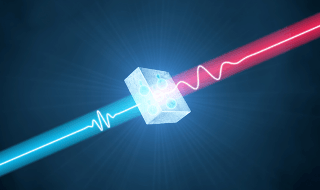Apr 25 2018
The building blocks of all life forms are molecules. Similar to every other organism, humans are also made of molecules. The biorhythm of humans is controlled by molecules, and they can also reflect our state of health.
A research team headed by Ferenc Krausz from the Laboratory for Attosecond Physics (LAP) - a joint effort of Ludwig-Maximilians-Universität (LMU) and the Max Planck Institute for Quantum Optics (MPQ) in Munich - intends to use bright infrared light for the analysis of molecular disease markers in considerably greater detail, for instance, to enable cancer diagnosis at an early stage. The researchers have created a robust femtosecond light source with the ability to emit at wavelengths between 1.6 and 10.2 μm. They hope that this device will enable the detection of organic molecules that exist in aspirated air or blood in very low concentrations.
 An artistic view of frequency conversion from near-infrared to mid-infrared through a nonlinear crystal. (Image credit: Alexander Gelin)
An artistic view of frequency conversion from near-infrared to mid-infrared through a nonlinear crystal. (Image credit: Alexander Gelin)
Countless molecules interact in largely particular ways with light of specific wavelengths in the mid-infrared region. Each type of molecule in a sample absorbs specific wavelengths and imprints a particular signature on the transmitted beam, which functions as a molecular fingerprint. The fingerprints of various molecular structures can be detected instantly by using a broadband mid-infrared light source—for instance, in a sample of aspirated air or blood. In case the sample consists of marker molecules that are related to particular disease states, the transmitted infrared light spectrum will reveal the presence of these molecules as well.
At present, physicists from LAP have developed such a light source, with the ability to cover the wavelengths between 1.6 and 10.2 μm. The laser system provides watt-level average output power and can be focused well, resulting in a very brilliant infrared light source. This attribute improves the capacity to detect molecules that exist in very low concentrations. Moreover, the laser has the ability to yield trains of femtosecond pulses, which enables performing time-resolved and also low-noise and more precise measurements. One femtosecond is equal to one-millionth of one-billionth of 1 second, or 10−15 seconds.
Currently, infrared spectroscopy is largely dependent on the use of incoherent light, which enables coverage of the entire mid-infrared region. Yet, the comparatively low brightness of the beam generated by incoherent sources evidently minimizes the capacity to detect very weak molecular fingerprints. Synchrotron radiation generated in particle accelerators can be used as a substitute; however, these facilities are very expensive and are sparse. On the other hand, laser-based techniques can produce even brighter beams when compared to synchrotrons. At present, the LAP physicists have been successful in developing a coherent light source that produces brilliant laser light over a wide spectral region in the infrared range. This was earlier the major disadvantage of laser sources. Also, the innovative system has a considerably smaller footprint (and is quite less expensive) when compared to a synchrotron: it can be fit on a large table.
Of course, there is still a long way to go until we can diagnose cancer at much early stage than at present. We need a better understanding of disease markers and we have to design an efficient way to quantify them, for example. But now having significantly improved light sources available, we can begin to tackle these issues.
Marcus Seidel, Study Researcher
Furthermore, the new laser system can be applied in fields other than the biosciences. Essentially, the precise detection of molecules and their transformations is central also to chemistry as well as physics.